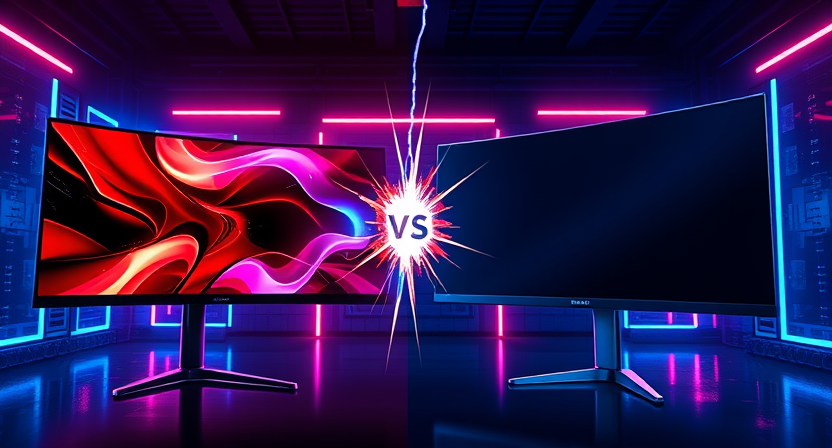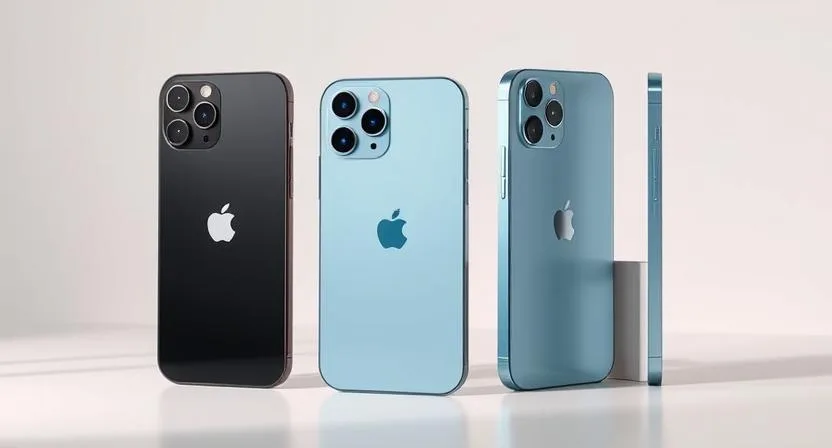Selecting the proper work monitor might be challenging. Thinking about Curved vs Flat Monitor. The arrival of curved monitors to the market has made choosing much more difficult, as if the profusion of monitors on the market wasn’t enough to distort the mind.
What then distinguishes a flat from a curved monitor, and which would be better for you? This page will go over the variations between curved and flat displays and help you decide which one is best for you.
Although the variations between these two configurations might surely be quite perplexing, in this post we will discuss the several elements you should take into account before choosing a flat or curved monitor for your work environment.
Difference Between Curved vs Flat Monitor

We want completely replicated game environments. However, not all firm employees may like this. Increasingly, our professional lives necessitate numerous displays, and for creative individuals, the distinction between work and pleasure may become even more blurred. Curved screens, usually used in gaming. That are being considered for offices. Are curved screens handy at work? Immersive design may boost attention and reduce eye strain, but not in all jobs. However, flat screens are flexible. Curved or flat monitors may also depend on personal preferences for leisure time on a home PC used for business.
Which, therefore, ought one to choose? Curved displays and flat monitors first seem to vary primarily in their screen design. On closer inspection, though, we find a number of elements that distinguish them. Indeed, on paper, curved and flat monitors have somewhat equal color quality, IPS panel, resolution, and refresh and response speeds. And choosing a curved or flat display for business work will not cause you to overlook any important aspects. Still, there are some characteristics of every kind of monitor that can make one more fit for a given use than the others. Let us explore the variations between flat displays and curved screens.
Which Have the Best Quality of Color?
The spectrum of colors that flat and curved displays can show differs as well. Because every pixel on a curved display is precisely slanted toward the eye, curved monitors typically outperform flat panels.
More severe angle-dependent color changes arise from colors on a flat display distorting as they travel away from the eye. For some uses, this might render them unreliable. HDR is becoming more and more popular among displays because of its great brightness, brilliant whites, and deep blacks; many flat monitors also include HDR, which helps to somewhat solve this issue.
Which Has The Higher Refresh Rate?
The model, pricing, and whether you decide on a flat or a completely curved display all affect the great range of refresh rates available. For the most costly curved models, options include the conventional 60Hz seen in budget monitors straight up to refresh rates of 240Hz or even higher. Given their greater scale, curved displays with comparable refresh rates would cost more than their flat-screen equivalents.
Although the budget is low, don’t worry; in terms of work, the refresh rate is not as important as it is for gaming or other activities requiring rapid responses to color changes and motions. For most occupations and tasks, then, the refresh rate is less of an issue.
Are Curved Monitors Bigger?
Curved monitors are often bigger than flat-screen monitors, as their width and more complicated proportions call for additional material to be utilized in their production. This problem is exacerbated by the bigger size meant to engage the user’s peripheral vision. In most circumstances, this implies that in essence a curved monitor will take more desk space than a flat-panel monitor of the same screen size. When weighing one curved display against two flat monitors, personal taste and workspace efficiency usually dictate the decision.
Use of Space in Curved vs Flat Monitor
Regarding space economy, flat displays provide a benefit. Their shape makes integration into other configurations—such as wall mounting or fitting into small workstations—easier. Less desk space is used by flat displays, and their configuration and positioning give more freedom. On the other hand, curved displays can provide a more immersive viewing experience in the debate of curved monitors over flat ones for work, thereby maybe improving productivity in jobs needing concentration. For work, then, is a curved monitor better? It depends on personal preferences and workplace restrictions, as curved monitors may demand additional desk space and certain orientation to leverage their advantages.
Which Are Heavier, Curved vs Flat Monitor?
The weight of the curved gaming display rises in tandem with its breadth and size. Curved monitors so often weigh more than flat-screen monitors. Because of their size, curved gaming monitors may also need a bigger workstation or dedicated gaming station to suit them correctly. If you use a standing desk, this is important knowledge as you want to make sure your motors can withstand the additional weight!
Are Curved Monitors More Expensive?
Simply by virtue of their size, curved monitors sometimes cost more than flat ones. Most curved displays are bigger; hence, they consume more materials and often have a higher total cost as well.
Ideal Viewing Distance
The viewing distance is somewhat constant when comparing curved panels with flat monitors. Curved screens provide an appearance of distance and depth by mimicking human eyesight using the curve of the panel. While for most curved displays give a more pleasant and immersive viewing experience once you get used to them, flat panels lack this natural depth here.
Therefore, a curved screen better conforms with the curvature radius of the cone of vision, even if you would sit at the same distance from the screen, therefore offering a more pleasant viewing experience. This can assist in lowering associated diseases and eye strain.
Screen Ratios of Curved vs Flat Monitor
The screen ratio for flat and curved displays varies. With a screen ratio of 21:9, curved displays often show breadth 2.3 times their height. For gamers especially, a larger field of view resulting from a greater screen ratio is often desired. For typing, reading, and focusing on details on the screen, flat panels’ reduced aspect ratio and smaller field of vision might be advantageous.
What is a curvature rating?
Curved and flat-screen monitors have somewhat different display sizes and measurements. Measurements such as 1000R or 1800R mark curved monitors; the letter “R” denotes radius, and the number before it denotes the millimeter measurement. By comparison, flat-panel displays are measured diagonally across the rectangle of the whole screen itself.
Which Has the Best Immersive Qualities?

Curved and flat displays provide quite different immersive experiences. While Curved displays give an illusion of bigger display margins than they really possess. Split-screen 2.0 technologies also enable numerous reasonably sized windows from curved displays, hence boosting the immersive impact of curved models.
Whether it’s a game or another application, the curvature of these displays offers a more immersive experience by “filling in” the users peripheral vision, thereby enabling them to feel totally immersed in the presented material, and may be quite good for visual work.
Are Curved Monitors Better for Eye Comfort?
Our eyes naturally perceive the world in a curled shape due to our peripheral vision, or what we see in the corner of our eyes. Designed to enhance the field of view when working, curved screens help to decrease eye movement, hence lowering eye strain. Numerous studies—including this one from 2023—have demonstrated that side-by-side configurations of flat monitors are far less pleasant for the eyes than curved screens. For programming, however, is a curved monitor appropriate? The immersive shape of a curved display can help developers focus better and view numerous windows side by side or lengthy lines of code more easily, hence perhaps enhancing productivity and comfort during longer coding sessions.
Preventing Screen Glare
Since flat-screen monitors are more prone to glare, the positioning of them in your house or office is absolutely important. Because of its curved shape, which helps to decrease reflections and hence lessen the influence of outside light sources, curved monitors often show less effect from glare. Curved displays find their own in well-lit, bright surroundings with lots of windows or strong illumination. If you have flat-screen displays, consider your location, as, in direct light, they will glare back at you.
Which Has Better Aesthetics? Curved vs Flat Monitor
The visual attractiveness of flat and curved displays is arbitrary and based on personal taste. Curved monitors would appeal to companies with a more current ethos and aesthetic as they usually have a sleeker, more modern appearance that can improve the general visual attractiveness of a workplace. Conversely, flat displays have an almost vintage look that fits quite nicely in many settings.
Curved and Flat Screens For Multi-Screen Setups
Given its curvature, mounting a curved computer monitor on an office desk can prove difficult. Especially if several monitors are involved, limited space might make it challenging to arrange your screens ergonomically. Two curved displays side by side might provide a very difficult setup. By comparison, flat displays are easier to position and connect. When connected, curved monitors demand exact centering to guarantee that the curvature sufficiently covers the whole field of vision of the viewer.
Could it Effect my existing hardware? Curved vs Flat Monitor
Only so many pixels fit on one screen. The number of pixels increases with display width. This is vital when choosing a curved monitor for your needs. Working on an ultra-wide monitor or playing games requires a graphics card that can handle the extra output. Your work duties and desk space will decide the best-curved display size. For production projects, 34–38-inch monitors give ample screen real estate without becoming overwhelming. Read your system requirements and consider changing your graphics card to match the resolution before buying.
Device Compatibility
When selecting monitors, compatibility with other devices is clearly a major factor; nevertheless, you would be amazed how few check. Both kinds of display normally provide a range of connections, as you would anticipate; therefore, you can usually rely on a range of HDMI, DisplayPort, and USB connectors. Double-check to be sure the selected monitor has the required connections to connect to your equipment.
Pros and Cons of Curved vs Flat Monitor

Let us now weigh the advantages and drawbacks of curved displays next to flat ones for use at work. Their immersive qualities and distinctive form have attracted a lot of interest for curved displays, which provide advantages like lower eye strain, improved concentration, and a more natural viewing experience. Though how many of them you really need in the office, they have various benefits not available in flat-screen displays. Here are the advantages and drawbacks of working on curved monitors:
Advantages of Curved Monitors
- Particularly helpful for game and graphic artists who want to be totally involved in their work and need a large spectrum of vision, curved displays offer a better feeling of immersion.
- Perfect for Multi-Tasking: Curved monitors’ ultra-wide screens provide enough area for several tabs and programs, therefore saving the need for a third monitor or multi-monitor arrangement.
- Appropriate for High-Resolution Work: Most vocations, such as graphic design or video editing, fit curved displays as they need high-resolution images.
- Especially during extended work hours, the monitor’s curved shape matches the natural curvature of the human eye itself, therefore lowering eye strain and offering a more pleasant viewing experience.
Disadvantages of Curved Monitors
- Curved displays’ larger shape calls for strong support, so they often weigh more than their flat counterparts.
- Graphic Card Requirement: A suitable graphics card is required to completely use the features of a curved monitor.
- Initially, it might take some time to get acclimated to the curved display—especially if you are used to flat screens.
- Higher Cost: Generally speaking, a curved screen is more costly than a flat-screen alternative; hence one monitor represents a major outlay of funds.
Often called straight monitors, flat-screen monitors have long been a mainstay in most offices. Their simplicity, adaptability, and simplicity of integration into many systems make them preferred. Curved displays might be the superior option, particularly for professionals in creative professions like design or video editing, for jobs needing high color quality or a more immersive viewing experience, nevertheless. Let’s examine closely the advantages and drawbacks of working with a flat-screen monitor:
Advantages of Flat Monitors
- Flat displays provide easy handling and setup by their lightweight nature and simplicity.
- Usually speaking, flat displays are more reasonably priced than curved ones.
- Appropriate for Simple Work Requirements: Without the need for sophisticated features, they fit perfectly for basic tasks.
- Flat displays support a greater aspect ratio, therefore generating a longer horizontal viewing area.
- Creating multi-monitor arrangements is best accomplished with flat displays.
Disadvantages of Flat Monitors
- Flat panels lack the totally immersive viewing experience that curved monitors offer.
- The visual quality close to a flat screen’s edges might not be as crisp or vivid.
The ultimate choice between a curved or flat monitor will rely on personal tastes and necessities. A curved monitor with a high refresh rate and wide screen ratio would be the perfect fit for players and those looking for a more immersive experience at work. Conversely, a flat display might provide practicality, simplicity of setup, and space economy for jobs connected to business where refresh rates are less important.
When making decisions, take into account elements including cost, viewing angles, distance, screen ratio, color accuracy, immersion, eye comfort, and screen glare. Think about space use and, last, aesthetics for multi-screen configurations. Not to overlook compatibility either. Just follow the advice above; you should now be able to choose which kind of monitor best fits your needs.







